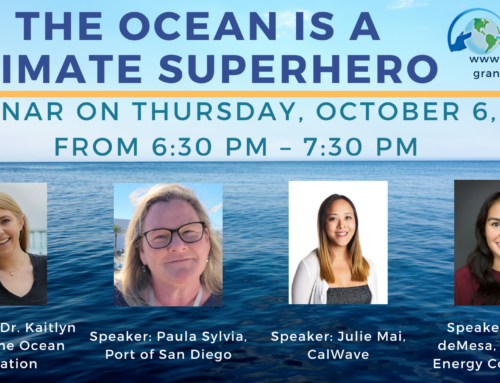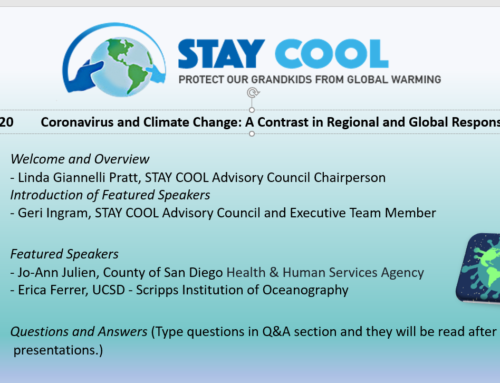Blog post by Peg Engel.
Nothing’s better for conveying a natural history lesson – and when the subject is sea level rise, no location could be more informative than our own Scripps Pier in La Jolla. On Thursday, February 19, during a “king tide,” STAY COOL members were treated to a field trip – a tour of the pier with researchers from UCSD’s Scripps Institution of Oceanography (SIO).
 Our Administrative Director, Sarah Benson, put together a great program with SIO coastal-studies faculty Dr. Ron Flick and Dr. Sarah Giddings. We met at La Jolla Shores just before the morning’s high tide and walked the shoreline north to the pier, while our guides explained the significance of “king tides.” This is a popular term used to describe periodic peak tides that occur when the earth, moon, and sun are specially aligned. Coastal erosion, flooding, and damages occur in California when storm waves and surges and El Niños coincide with king tides. For more about king tides and astronomical relationships that produce them, see these graphics on the SDUT website.
Our Administrative Director, Sarah Benson, put together a great program with SIO coastal-studies faculty Dr. Ron Flick and Dr. Sarah Giddings. We met at La Jolla Shores just before the morning’s high tide and walked the shoreline north to the pier, while our guides explained the significance of “king tides.” This is a popular term used to describe periodic peak tides that occur when the earth, moon, and sun are specially aligned. Coastal erosion, flooding, and damages occur in California when storm waves and surges and El Niños coincide with king tides. For more about king tides and astronomical relationships that produce them, see these graphics on the SDUT website.
At 9 am on the day of our tour, the tide was 6.3 feet higher than average low tide. Our group experienced this first hand as we waded through surf to reach the far side of the pier. Once out on the pier, we were distracted by great views of breakers and dolphins, but eventually turned our attention to the pier’s real purpose – data collection. What is now the Ellen Browning Scripps Memorial Pier was first built in 1914, and tide measurements have been collected since 1924. Today SIO shares pier data with the public online.
 Over the last century, sea level in our region has risen 6-7 inches. Since 1993, the rate of sea level rise has doubled, and it’s still accelerating: sea level is expected to rise nearly three times faster between now and 2050. With higher sea levels, our shoreline communities will be more vulnerable to beach loss and coastal cliff erosion during heavy storms. According to The San Diego Foundation’s “2050 is Calling” report (https://www.sandiego.edu/2050/), we could see what is currently a 1-in-100-year extreme coastal flood occur as frequently as every year by 2050.
Over the last century, sea level in our region has risen 6-7 inches. Since 1993, the rate of sea level rise has doubled, and it’s still accelerating: sea level is expected to rise nearly three times faster between now and 2050. With higher sea levels, our shoreline communities will be more vulnerable to beach loss and coastal cliff erosion during heavy storms. According to The San Diego Foundation’s “2050 is Calling” report (https://www.sandiego.edu/2050/), we could see what is currently a 1-in-100-year extreme coastal flood occur as frequently as every year by 2050.
Directing attention back to shore, we noted how much at-risk property and infrastructure are publicly owned. Besides damage to coastal homes and businesses, we can anticipate costly damage to transportation byways, ports, airports, schools, and military centers.
At our next STAY COOL member meeting, Dr. Flick will present some of his research in more detail, including studies on the Ross Ice Shelf. Please join us next Wednesday – March 4th – to learn more about SIO research, and to explore what can be done about anticipated impacts to ecosystems and coastal infrastructures due to sea level rise. Click here to download the STAY COOL March 4 2015 Event Announcement (PDF) or email sarah@staycool4grandkids.org for more details.




